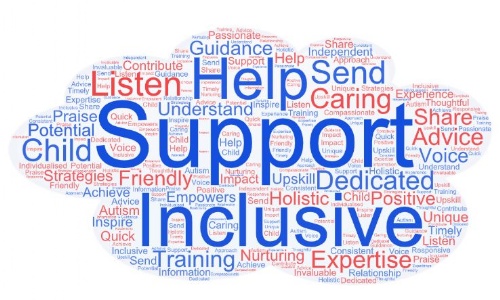EHCPs - what are they and do we need them?

Since taking on the role of SENCO in 2023, I’ve tried to make it my mission to “demystify” SEND at Prince Henry's, so staff, students and parents can all feel confident in how to navigate the special needs landscape in a mainstream secondary school setting. The trouble is, it feels like the system is stacked against us; you’ll likely have seen the national news articles crying out about the lack of funding, lack of staffing and potential major overhauls to SEND policy in the incoming government white paper. It often feels like, despite a better national and cultural understanding of the importance of special needs support in schools, the way to get to more timely and effective provision is still a mystery.
In amongst this uncertainty, we strive to support all our young people to succeed with the limited resources we have at our disposal, whatever their level of need. As part of the work to support students and parental desire to have the best support for their child one of the most common queries that I get from parents is how and when to apply for an EHCP.
It feels like almost every SEND diagnosis report indicates an EHCP could be the answer and social media promotion of them pushes this as the only way to secure support for children in schools. I wanted to use this opportunity to help people truly understand how they work and the evidence needed to get one.
So, what is an EHCP?
Education, Health and Care Plans were designed to unite the three strands of schools, medicine and social care to protect the legal rights of the most vulnerable students and to ensure that multi-agency teams were working together to support them into adulthood. They were/are intended to be reserved for those with a level of need that goes beyond what a mainstream secondary school can deliver alone. In some ways, this has become a misnomer – many children are now being granted EHCPs without the involvement of all these teams. In a world where all the services are over-stretched, the “Education” part of the EHCP world can feel like a bit of a lonely place and schools are asked to do more to help the children in their care.
An EHCP is a legal document, agreed by the Local Authority and reviewed annually, that specifies the level of support that a child needs from the teams supporting them. Applications can be made by schools, parents, medical teams or social care (or even the child themselves, if they are over 16). It is written, in the first instance, by an Educational Psychologist, and then is edited every year by the parents, child, school and other involved teams to ensure that the provision stays relevant for the child as they move into adulthood.
What does it get you, exactly?
- An EHCP grants a child a level of legal protection, where the school and other teams are bound by the provision laid out in the plan (although, as I will explain later, this is sometimes easier said than done).
- Education until the age of 25. As most children with an EHCP have learning difficulties that mean that mainstream curriculum or traditional career pathways may be harder to follow, they are granted the legal right to remain in free education up to 25. They end if a child goes to university (as they have different funding structures and function across different Local Authorities) but remain in place for apprenticeships and supported internships
- The ability to apply for education in a specialist placement, if needed. The child gets priority for admissions at the school of their choice (as long as there are places available and that the school and parents agree to work together to attempt to meet the provision in the plan)
- Extra funding for the school, to support the provision outlined in the plan
Sounds great, right? Except there are many pitfalls on the road to getting one and, with the massive upsurge in applications from both parents and schools in the last few academic years, some argue that they are becoming unfit for purpose and that overstretched services are unable to meet the provision consistently.
So, how do you get an EHCP for a child?
To get an EHCP, you need to prove two very important things -
- That a child has SEND.
- That they require long term, high level SEND support and that, even then, they are not making much progress academically
Number 1 is often the easy part. Many children have a diagnosis of SEND, which certainly helps to make the case! However, a diagnosis is not always needed (which is lucky, what with the waiting lists for assessment being years long currently). If the parent, or school, can prove a pattern of need that indicates a child has SEND, then this meets the threshold.
It is number 2 that causes the most difficulty (and, frankly, conflict). What counts as “long term” is two terms or more, meaning that schools especially must take their time to gather the relevant evidence. I cannot make an application for a Year 7 student, for example, until after Easter of their first year, which is a very long time in the life of a child who may be struggling with the step up to secondary school. The “high level” nature of the support also has different meanings to different people – some parents are washing, dressing, organising and entirely scaffolding life for their children outside of school but, while in school, the child masks their need and only requires some generalised prompting. The level of educational support that I need to evidence for EHCP needs to be personalised – the SEND or pastoral teams of school, medical teams or therapists, social care or parent support of a child must be intense, continuous and unlikely to change. It is this hurdle that most applications fall down on.
Essentially, we already need to be supporting a child to EHCP level to get an EHCP.
Issues with EHCPs
- The funding. With the average EHCP for a child with social communication difficulties bringing in around £4000 a year, the money that these plans bring in is rarely enough to cover the real staffing, equipment or support costs of the students that they are written for
- Staffing. Getting an EHCP, even if funded at a high level, does not mean that there are immediately more staff available (such as classroom-based TAs) or staff trained to the appropriate level in the school named on the plan. Support is often shared and services stretched, so it takes time or adaptation to meet the needs of the child
- Over-subscription. Specialist placements are over-subscribed nationally and there is a huge job for educators to do to make spaces available, but also to further adapt mainstream to make it more accessible for students with high levels of need
- Provision. When an EHCP is written and sent to a school to see if they can meet the needs in the plan, it is increasingly common that schools have to reply saying no. For example, any plan that asks for a student to be supported in all their lessons by an additional adult, I have to say no to. With 32 students with an EHCP in the school, and far fewer Teaching Assistants than that, I cannot promise that I can meet that legal level of provision. It is then down to the parent to decide if they are happy to still send the child to the school, potentially already diluting the support outlined in the plan
- Attendance in education is key. There are many children who are unable to attend school due to mental health difficulties, sensory overwhelm or due to lack of appropriate support, but evidence of non-attendance is not enough to meet the threshold for EHCP. In these cases, medical or therapeutic support is necessary but, with those services also stretched and severely limited, there are many children for whom accessing this is impossible.
So, are they worth it?
For any child with complex needs that require a high level of support into their future, an EHCP is certainly worth it. That is why there was such a public outcry when it was suggested that the government may be thinking of scrapping them entirely. There will always be children who require support above and beyond that which is typical, and it is crucial that their rights are legally protected into the future. That personalised level of support, while hard won and often flawed, is a lifeline to many children and families and give agency to those who may otherwise be left to struggle.
Having said that, it is a school’s job to make their best endeavours to meet the needs of the children in their care, whether that child has an EHCP or not, so I would always recommend open and honest discussions between parents, staff and the SEND team, so no child is disadvantaged by their needs and no family is left trying to navigate this complicated system without support.

